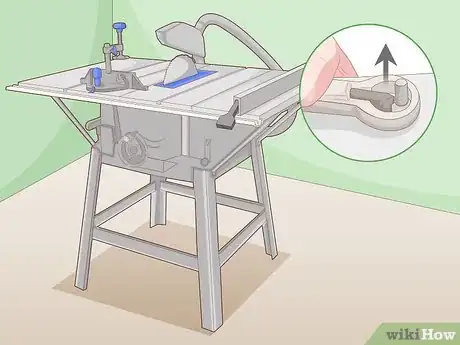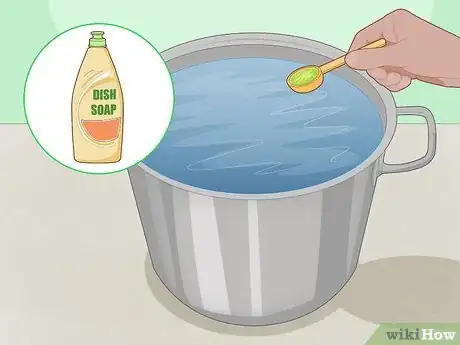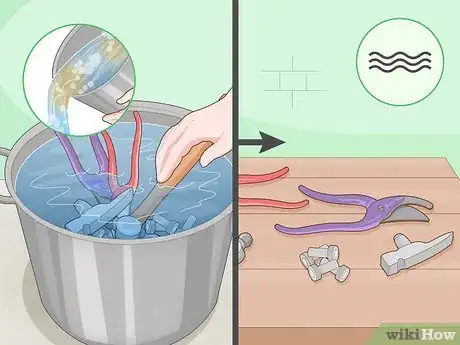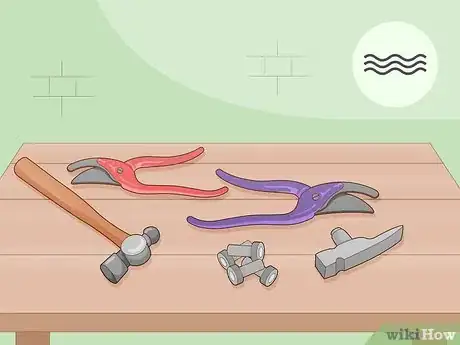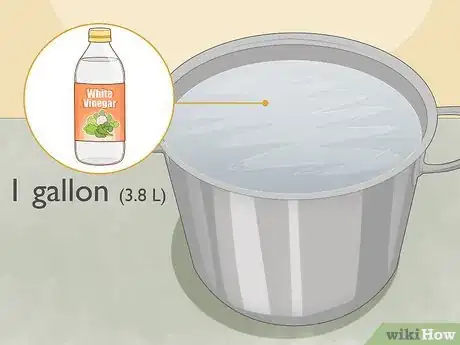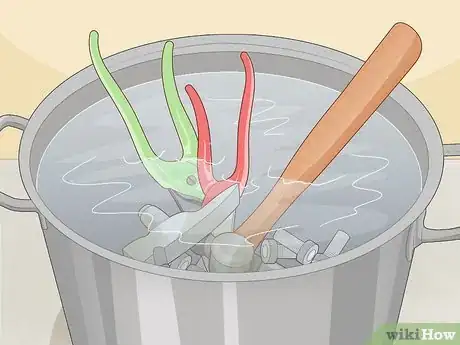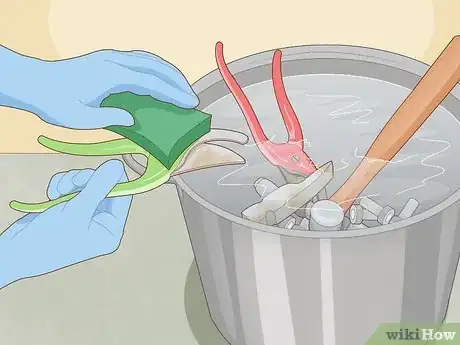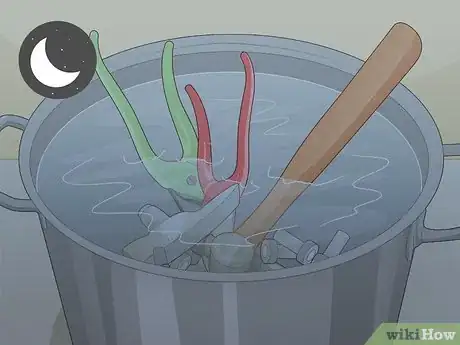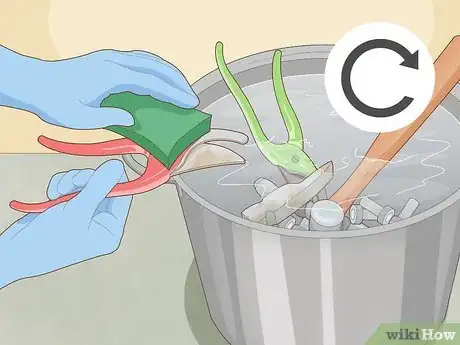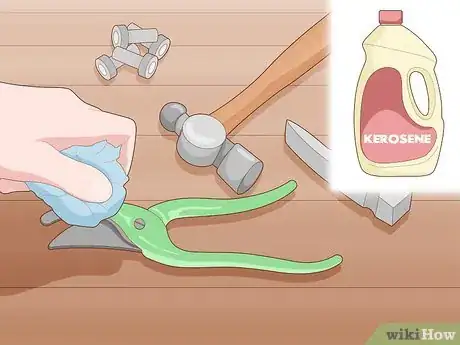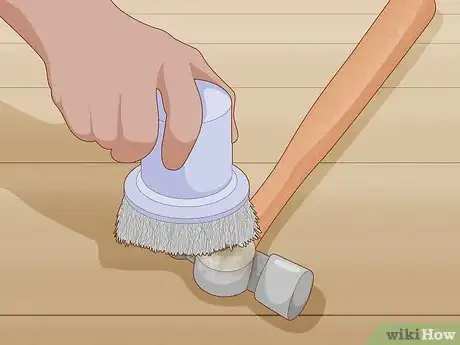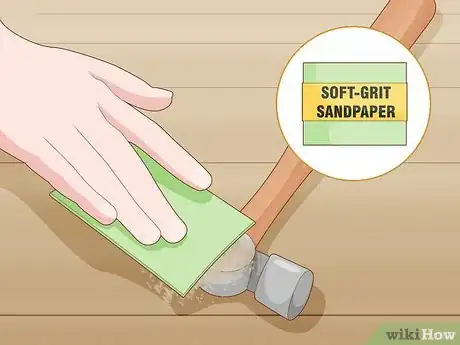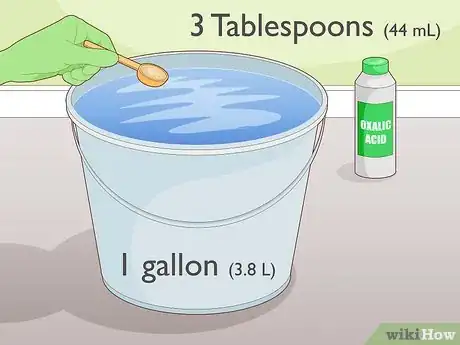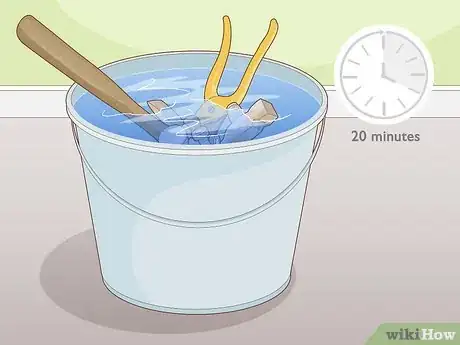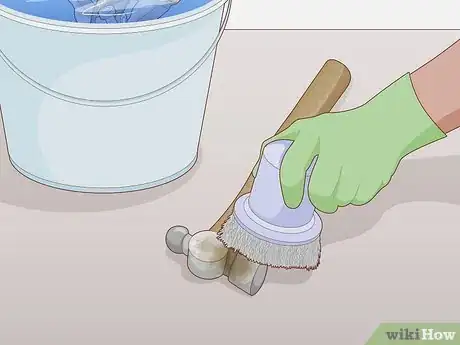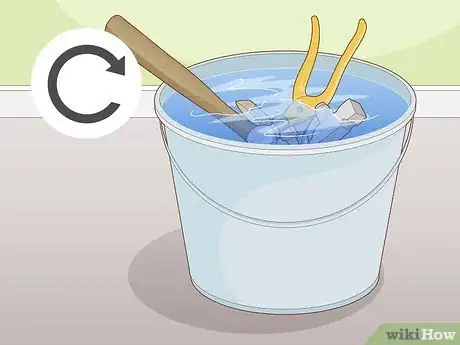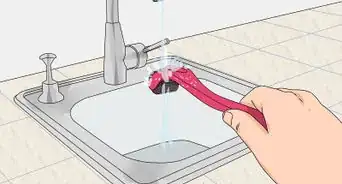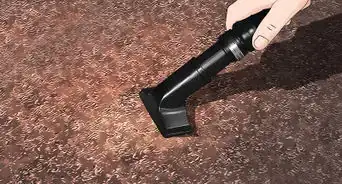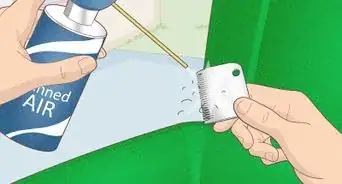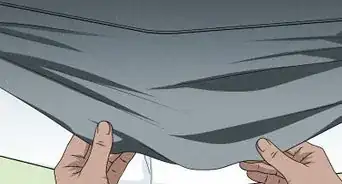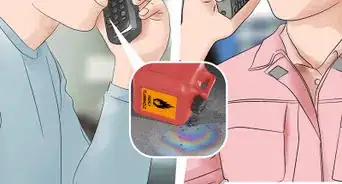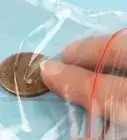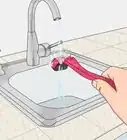This article was co-authored by Eduardo Peralta and by wikiHow staff writer, Janice Tieperman. Eduardo Peralta is a House Cleaning Specialist and the Manager of Best Maid House Cleaning based in San Jose, California. With over five years of experience, Eduardo and the Best Maid House Cleaning team specialize in home deep-cleaning, post-construction cleaning, and green and eco-friendly cleaning services. Best Maid House Cleaning is fully licensed and insured.
This article has been viewed 12,616 times.
After many years or decades or use, your tools might need a little TLC. To get rid of stuck-on dirt and grime, wash your tools with dish soap and water, then condition them with linseed oil. If your tools are rusting, soak them in a solution of white vinegar or oxalic acid and scrub them off with an abrasive pad or brush. With a little effort and regular maintenance, you can have a cleaner, more efficient set of tools on hand!
Steps
Removing Dirt and Grime
-
1Take apart any large tools to give them a more thorough cleaning. Examine your tool and see if it can be easily soaked and washed in its current state. If it’s a larger item, like a table saw, remove any bolts, screws, nails, or other items securing the metal components to the rest of the tool. Set these items aside, so you can reassemble your tool later on.[1]
- If you aren’t sure how to disassemble your tool, contact an experienced friend or hardware store associate for assistance.
-
2Fill a large bucket with water and a spoonful of dish soap. Pour warm water into a large bucket, basin, or other sturdy container. Next, stir in 1 US tbsp (15 mL) or so of dish soap into the water, until the mixture looks sudsy.[2]
- Dish soap is a useful ingredient for cleaning tools, since you’re trying to remove dirt and grease from the metal.
Advertisement -
3Place the metal portions of your tools in the sudsy water. If your tools are made entirely of metal, arrange them in the soapy water so they can soak. If you’re cleaning a tool with wooden components, like a handsaw, rest the metal blade in the water instead of the handle. In this case, you don’t need to wait for the tools to soak; instead, you can start cleaning them right away! [3]
- You don’t want to damage any old or antique wood handles by soaking them in water.
-
4Work off stubborn dirt stains with an abrasive pad. While the tools are still soaking wet, use an abrasive pad to remove any stuck-on patches of grime. Apply as much pressure as you need, moving the pad in small, forceful movements until the dirt is completely gone. Once you’ve cleaned off 1 side of the tool, flip it over so that you clean off the opposite side.[4]
- Only focus on the metal portions of your tools with this mixture.
- If your tools are antiques, consider using a sponge instead of an abrasive pad.
-
5Rinse and dry off the tools to get rid of any soap. Dump out the soapy water from your bucket, then refill the container with clear, clean water. Dip and rinse your tools in the clean water to get rid of any leftover soap or suds. Once they’re fully cleaned off, use a clean washcloth or rag to wipe away any excess moisture.[5]
- It’s much more efficient to wipe your tools off than to let them air-dry.
-
6Massage linseed oil over your tools to prevent rust. Pour a grape-sized amount of linseed oil onto a clean rag, then rub the substance into the metal surfaces and wooden handles of your tools. Wait 5 minutes for the oil to soak into the metal, then wipe away any leftover product.[6]
- Adding a layer of oil helps protect your tools from future rusting.
- Camellia oil can also work for this.
-
7Reassemble and store your tools in a cool, dry place. If you had to take apart your tool during the cleaning process, use the displaced screws and bolts to put it back together. Once your tools are dry and fully assembled, find a toolbox or other dry place where you can keep your items for a long-term basis. Check that the area isn’t moist, and that your tools can receive plenty of dry, open air in the process.[7]
Soaking Rusty Tools in Vinegar
-
1Pour 1 gallon (3.8 L) of white vinegar into a large bucket. Find a large plastic container that’s industrial-grade and won’t wear down after holding acidic substances. Next, fill this bucket with 1 gallon (3.8 L) of white vinegar, so you can fully submerge and soak your tools. Additionally, set a large piece of wood aside that can be used to cover the bucket.[8]
- If you’re working with larger tools, consider filling a basin or tub with vinegar instead. In this case, you may need more than 1 gallon (3.8 L).
- If you don’t want to use vinegar, you can also fill the bucket with warm water and dish soap.[9]
-
2Soak your rusty tools in the vinegar for 4 hours. Arrange your rusted tools in the vinegar, checking that they’re completely submerged as you go. Next, set a timer for 4 hours, so your tools have enough time to soak. To prevent any of the vinegar from evaporating, cover the bucket or basin with a large sheet of wood.[10]
- If your tools are severely rusted, you might want to let them soak for 6-8 hours initially.
-
3Wipe away the rust with an abrasive pad. Remove the tools from the bucket after several hours of soaking, then arrange them on a flat, clean surface. Take an abrasive, coarse-grit pad and scrub at any rusty areas of the tool. As you remove the rust, switch a softer, fine-grit pad to buff the metal surface of your tools.[11]
- Steel wool can also be a useful tool to remove rust.[12]
- You can purchase abrasive pads or sandpaper at your local hardware store.
-
4Let the tools soak overnight to soften any remaining rust. If your scrubbing doesn’t get rid of all the rust, try submerging your tools in white vinegar for a longer period of time. Leave the tools to soak overnight to soften the rust a bit more. Before you leave the area, place the wooden sheet over the bucket again so the vinegar stays covered.[13]
-
5Scrub the rust again with an abrasive pad. The next day, remove your tools from the vinegar mixture once more and place them on a flat, clean surface. Use the same coarse-grit pad to work away any layers of rust.[14] As you remove the rust, buff the surface of the tool with a softer pad, so the metal can look smooth and shiny.[15]
- Depending on the severity of the rust, it might take a lot of elbow grease to get your tools clean again. Don’t give up!
-
6Rinse and dry off the tools completely. Once the tools are completely clean, spray over them with a garden hose. Aim to clean off both sides of the tools, so their surfaces are free of vinegar. After they’re fully clean, wipe down the tools with a clean rag to get rid of any excess moisture.[16]
-
7Apply a layer of kerosene to the tool if the rust remains. Soak a rag with kerosene, then rub it over the metal surface of the tool. Rub both sides of the tool, so the metal is fully lubricated. Once you’re finished using the kerosene rag, be sure to dispose of it safely.[17]
-
8Rub away any rust with a wire-bristled wheel. Attach a wire-bristled brush or wheel to the drill bit, then power on your drill. Move the tool along the length of the metal surface to polish and buff the tool. Only use the brush on areas that you’ve conditioned with kerosene, or else you may not be able to polish the metal properly. [18]
- This process helps you to polish and buff the surface of your tools more effectively than an abrasive pad.
-
9Clean off any dust or rust with soft-grit sandpaper. Turn off your electrical drill, and scan the surface of your tool for any lingering specks of rust or dirt. Rub a sheet of smooth, fine-grit sandpaper over the metal surface with short, forceful movements to finish polishing the tool.[19]
Getting Rid of Rust with Oxalic Acid
-
1Put on protective glasses and gloves before working with the acid. Find a well-ventilated area where you can soak and clean your old tools without inhaling any acidic fumes. To protect your eyes, slip on a pair of safety goggles or glasses. Additionally, wear a pair of rubber gloves to prevent your hands from coming into contact with any acid.[20]
- Try working in an outdoor area for this process. If you don’t have enough room outside, set up a box fan in your workspace to keep the air moving.
- If your tools are severely rusted, you might want to use oxalic acid instead of white vinegar.
-
2Combine 3 tablespoons (44 mL) of oxalic acid with 1 gallon (3.8 L) of water. Fill a large, industrial-grade plastic bucket with water. Next, stir in a few spoonfuls of oxalic acid. Mix the ingredients together with a paint stirrer or other utensil to make sure that they’re completely combined.[21]
-
3Let your tools soak in the mixture for 20 minutes. Arrange the metal, rusty portions of your tools in the acidic solution, then set a timer for 20 minutes. If your tools are made entirely of metal, you can place the entire item in the bucket. If the items have wooden handles, only place the metal surface into the bucket.[22]
- While oxalic acid isn’t as potent as other acids, it’s still a pretty strong substance. To prevent your wooden handles from getting degraded, try to keep them out of the solution altogether.
-
4Remove any stubborn portions of rust with a wire brush. With your protective gloves on, remove the tools from the bucket. If the rust hasn’t soaked off completely, use coarse-grit sandpaper or a wire-bristled brush to scrub the surface of the tool. Apply an even amount of pressure, working in short, even strokes to remove the leftover rust.[23]
- Continue wearing your protective eye gear during this part of the process.
-
5Rinse the tools off with clean, cool water. While wearing gloves, remove your older tools from the mixture and set them aside. Next, run the metal portion of each tool under cool running water to get rid of any lingering acid. Once the tools are rinsed, you can set them aside on a flat, clean surface.[24]
- If you don’t rinse off the extra acid, it could do long-term damage to your tools.
-
6Soak the clean tools in a mixture of baking soda and water for 10 minutes. Pour at least 4 tablespoon (59.1 ml) (58 g) of baking soda into a bucket or basin filled with 5 litres (21 c) of water, then stir the ingredients together. Add your clean, rinsed tools into the mixture and let them sit for several minutes.[25]
Expert Q&A
-
QuestionHow do you prevent future rust on tools?
 Eduardo PeraltaEduardo Peralta is a House Cleaning Specialist and the Manager of Best Maid House Cleaning based in San Jose, California. With over five years of experience, Eduardo and the Best Maid House Cleaning team specialize in home deep-cleaning, post-construction cleaning, and green and eco-friendly cleaning services. Best Maid House Cleaning is fully licensed and insured.
Eduardo PeraltaEduardo Peralta is a House Cleaning Specialist and the Manager of Best Maid House Cleaning based in San Jose, California. With over five years of experience, Eduardo and the Best Maid House Cleaning team specialize in home deep-cleaning, post-construction cleaning, and green and eco-friendly cleaning services. Best Maid House Cleaning is fully licensed and insured.
House Cleaning Specialist Apply a rust inhibitor after cleaning the rust from the tool. You can also apply this product to any recently purchased tools (before using them for the first time).
Apply a rust inhibitor after cleaning the rust from the tool. You can also apply this product to any recently purchased tools (before using them for the first time).
Things You’ll Need
Removing Dirt and Grime
- Hose
- Soft brush or abrasive pad
- Dish soap
- Water
- Plastic bucket
- Linseed oil
- Rag
Soaking Rusty Tools in Vinegar
- White vinegar
- Plastic bucket
- Abrasive pad or steel wool
- Wooden sheet
- Water
- Kerosene (lubricant)
- Drill-powered wire wheel
- Soft-grit sandpaper
- Rag
Getting Rid of Rust with Oxalic Acid
- Eye goggles
- Protective gloves
- Industrial-grade bucket
- Oxalic acid
- Paint stirrer
- Wire-bristle brush or coarse-grit sandpaper
- Water
- Baking soda
References
- ↑ https://www.popularmechanics.com/home/tools/how-to/a14313/how-to-restore-rusted-old-hand-tools/
- ↑ https://www.bobvila.com/articles/how-to-remove-rust-from-tools/
- ↑ https://www.bobvila.com/articles/how-to-remove-rust-from-tools/
- ↑ https://source.colostate.edu/master-gardener-tips-caring-garden-tools/
- ↑ https://www.bobvila.com/articles/how-to-remove-rust-from-tools/
- ↑ https://source.colostate.edu/master-gardener-tips-caring-garden-tools/
- ↑ https://aces.illinois.edu/news/garden-tool-care
- ↑ https://www.popularmechanics.com/home/tools/how-to/a14313/how-to-restore-rusted-old-hand-tools/
- ↑ https://www.bobvila.com/articles/how-to-remove-rust-from-tools/
- ↑ https://www.popularmechanics.com/home/tools/how-to/a14313/how-to-restore-rusted-old-hand-tools/
- ↑ https://www.bobvila.com/articles/how-to-remove-rust-from-tools/
- ↑ https://www.popularmechanics.com/home/tools/how-to/a14313/how-to-restore-rusted-old-hand-tools/
- ↑ https://www.popularmechanics.com/home/tools/how-to/a14313/how-to-restore-rusted-old-hand-tools/
- ↑ https://www.popularmechanics.com/home/tools/how-to/a14313/how-to-restore-rusted-old-hand-tools/
- ↑ https://www.bobvila.com/articles/how-to-remove-rust-from-tools/
- ↑ https://www.popularmechanics.com/home/tools/how-to/a14313/how-to-restore-rusted-old-hand-tools/
- ↑ https://www.bobvila.com/articles/how-to-remove-rust-from-tools/
- ↑ https://www.bobvila.com/articles/how-to-remove-rust-from-tools/
- ↑ https://www.bobvila.com/articles/how-to-remove-rust-from-tools/
- ↑ https://www.bobvila.com/articles/how-to-remove-rust-from-tools/
- ↑ https://www.bobvila.com/articles/how-to-remove-rust-from-tools/
- ↑ https://www.bobvila.com/articles/how-to-remove-rust-from-tools/
- ↑ https://www.woodreview.com.au/how-to/removing-rust
- ↑ https://www.woodreview.com.au/how-to/removing-rust
- ↑ https://www.woodreview.com.au/how-to/removing-rust
